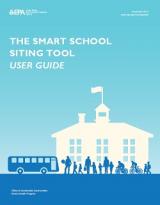Smart Growth and School Siting
Background
Where and how schools are built profoundly affect the communities they serve. Over the next few decades, thousands of schools around the country will be built and renovated. While a first-rate education in a safe facility must always be the primary consideration when making school spending decisions, a growing number of communities are using these investments to meet multiple goals — educational, health, environmental, economic, social, and fiscal.
Investments in schools both respond to and influence growth. Many communities that are reevaluating their growth patterns are also assessing how and where they spend their education dollars. The boom in school construction offers an opportunity to improve the quality of schools and communities together, by applying the principles of smart growth to educational facility planning.
Smart growth strategies include:
- Conserving resources and land.
- Offering choices in housing, transportation, shopping, recreation, and jobs.
- Encouraging community collaboration.
- Fostering distinctive, attractive neighborhoods.
A school's location affects student safety, community health, and the environment. A school that is safe and easy for students, teachers, parents, and other community members to reach on foot or by bicycle helps reduce air pollution from automobile use, protecting community health. Building schools compactly and in the neighborhoods they serve minimizes the amount of paved surface they create, which can help protect water quality by reducing polluted runoff.
EPA Resources
Some of the following resources
Publications
The Smart School Siting Tool (2016): Can help communities align school site selection with planning policies and capital investments, understand how school siting and other community planning processes are coordinated, and compare school siting alternatives.
Youth Travel to School: Community Design Relationships with Mode Choice, Vehicle Emissions, and Healthy Body Weight (2008): Examined if and how a variety of factors, including parental perception of neighborhood safety and neighborhood design, influence school travel. The study also examined air pollutants and CO2 emissions generated from school trips. (This publication is available in the EPA Archive; click on Search EPA Archive and type or copy and paste the title into the search box.)
Schools for Successful Communities: An Element of Smart Growth (2004): Explains why and how communities can use smart growth planning principles to build schools that better serve and support students, staff, parents, and the entire community. This publication helps communities invest in schools that will give children the best possible education, use taxpayer dollars wisely, and improve the quality of life for all residents.
Travel and Environmental Implications of School Siting (2003): Provides important information about how the location of a school affects how its students get to it. It shows that school siting and design can influence traffic congestion, air pollution, school transportation budgets, and children's health and obesity.
School Siting Guidelines (2011): Voluntary EPA guidelines that can help local school districts and community members evaluate environmental factors to make the best possible school siting decisions.
For more information on EPA's resources to help address and resolve environmental issues in schools, including information on chemical use, design and construction, indoor air quality, waste reduction, drinking water, energy efficiency, environmental education, and many other topics, please visit Healthy School Environments.
Webinars
Visit our webinars page for information about school siting and smart growth webinars hosted by EPA.
Other Resources
The following links exit the site Exit
Publications
Safe Routes to School By the Numbers: Using Data to Foster Walking and Biking to School, Safe Routes to School National Partnership, 2016.
Creating Communities of Learning: Schools and Smart Growth, Ellen Shoshkes, Ph.D., Education Law Center, April 2004.
dollars & sense: The Cost Effectiveness of Small Schools (PDF) (44 pp, 291 K, About PDF), Barbara Kent Lawrence et al., KnowledgeWorks Foundation, 2002.
"Edge-ucation," Rob Gurwitt, Governing, March 2004.
Local Governments and Schools: A Community-Oriented Approach, ICMA and Smart Growth Network, 2008.
On Common Ground: Smart Growth for Better Schools, multiple authors, National Association of Realtors®, Winter 2005.
Public Schools: A Toolkit for Realtors®, Carol Everett, Karen Lee Ryan, and Stephen Smith, National Association of Realtors®, 2005.
Schools as Centers of Community: A Citizen's Guide for Planning and Design (PDF) (80 pp, 8.2 MB, About PDF), Steven Bingler, Linda Quinn, and Kevin Sullivan, National Clearinghouse for Educational Facilities, KnowledgeWorks Foundation, Building Educational Success Together, Council of Educational Facility Planners International, Coalition for Community Schools, October 2003.
Organizations
The following links exit the site Exit
Coalition for Community Schools
National Association of State Boards of Education
National Center for Safe Routes to School
New Schools, Better Neighborhoods
Pedestrian and Bicycle Information Center
Rural School and Community Trust


